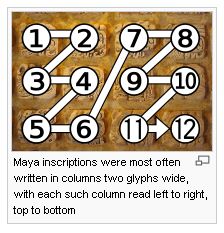- Previous message: André Szabolcs Szelp: "Re: Boustrophedon"
- In reply to: André Szabolcs Szelp: "Re: Boustrophedon"
- Next in thread: Asmus Freytag: "Re: Boustrophedon"
- Messages sorted by: [ date ] [ thread ] [ subject ] [ author ] [ attachment ]
- Mail actions: [ respond to this message ] [ mail a new topic ]
André, you're absolutely right. It was a bad example.
I've seen other examples of Maya that were written back and forth like Luwian, but I couldn't find the picture.
Thanks for the correction.
Clive
Clive P. Hohberger, PhD
VP, Technology Development
Zebra Technologies Corporation
333 Corporate Woods Parkway
Vernon Hills, IL 60061-3109 USA
(office) +1 847 793 2740
(mobile) +1 847 910 8794
(fax) +1 847 793 5779
(conference) +1 847 955 4768
________________________________
From: André Szabolcs Szelp [mailto:a.sz.szelp@gmail.com]
Sent: Sunday, November 09, 2008 7:44 AM
To: Hohberger, Clive
Cc: philip_chastney@yahoo.com; Unicode Mailing List; Doug Ewell
Subject: Re: Boustrophedon
That maya example as shown in the image is _not_ bustrophaedon, if the arrow is correct.
That's two columns of LTR (each column being two blocks wide).
If the reading would be 1-2-4-3-5-6, then it would be bustrophaedon.
2008/11/7 Hohberger, Clive <CHohberger@zebra.com>
Phil Chastney wrote on Wednesday, November 05, 2008 4:14 PM
so, are there any examples of boustrophedon writing where the letters are NOT mirrored?
/phil
Phil,
I'm only aware of hieroglyphic languages that were written boustrophredonically without mirror imaged characters. Unlike Egyptian hierogrlyphs which were written in the same direction in in parallel rows or column the lines of Luwian hieroglyphs are written alternately left-to-right and right-to-left. This practice was called by the Greeks <http://en.wikipedia.org/wiki/Ancient_Greek> boustrophedon <http://en.wikipedia.org/wiki/Boustrophedon> , meaning "as the ox turns" (as when plowing a field).
I am told that occaisionally ancient Chinese was written boustrophredonically, if I understood what I saw at the National Museum in Taipei, but I'm sure others know better than I.
Maya script (http://en.wikipedia.org/wiki/Maya_script <http://en.wikipedia.org/wiki/Maya_script> ) was written boustrophredonically, usually written in blocks arranged in columns two blocks wide, read as follows:
Regards,
Clive
Clive P. Hohberger, PhD
VP, Technology Development
Zebra Technologies Corporation
333 Corporate Woods Parkway
Vernon Hills, IL 60061-3109 USA
(office) +1 847 793 2740
(mobile) +1 847 910 8794
(fax) +1 847 793 5779
(conference) +1 847 955 4768
________________________________
From: unicode-bounce@unicode.org [mailto:unicode-bounce@unicode.org] On Behalf Of philip chastney
Sent: Wednesday, November 05, 2008 4:14 PM
To: Unicode Mailing List; Doug Ewell
Subject: Re: Boustrophedon (was: Re: Question about the directionality of "Old Hungarian" (document N3531))
--- On Tue, 4/11/08, Doug Ewell <doug@ewellic.org> wrote:
From: Doug Ewell <doug@ewellic.org>
Subject: Boustrophedon (was: Re: Question about the directionality of "Old Hungarian" (document N3531))
To: "Unicode Mailing List" <unicode@unicode.org>
Date: Tuesday, 4 November, 2008, 2:07 PM
Q: Why is this thread like boustrophedon itself?
A: Because it goes in two different directions.
It would be really neato if we could split the "principles of
boustrophedon" discussion off into a separate thread, called, oh, I
don't know, maybe "Re: Boustrophedon", and leave the present
Subject line for discussions that really do have to do with
Old/Szekler
Hungarian.
fair enough --- may I start with a query?
p218 of 'Reading the Past' (British Museum Press, 1990) says, "Some early Greek and South Arabian texts were written boustrophedon [...]. In such inscriptions the letters are often reversed to face the direction of writing."
that's "often", not "always"
unfortunately, the illustrations provided all show mirrored lettering
- CONFIDENTIAL-
This email and any files transmitted with it are confidential, and may also be legally privileged. If you are not the intended recipient, you may not review, use, copy, or distribute this message. If you receive this email in error, please notify the sender immediately by reply email and then delete this email.
-- Szelp, André Szabolcs +43 (650) 79 22 400

- Next message: Ruszlan Gaszanov: "RE: Question about the directionality of "Old Hungarian" (document N3531)"
- Previous message: André Szabolcs Szelp: "Re: Boustrophedon"
- In reply to: André Szabolcs Szelp: "Re: Boustrophedon"
- Next in thread: Asmus Freytag: "Re: Boustrophedon"
- Messages sorted by: [ date ] [ thread ] [ subject ] [ author ] [ attachment ]
- Mail actions: [ respond to this message ] [ mail a new topic ]
This archive was generated by hypermail 2.1.5 : Sun Nov 09 2008 - 10:20:16 CST